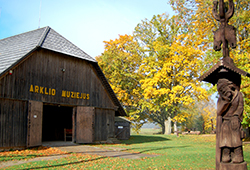Exhibits and events
Lithuanian heritage of national agriculture is stored in the only Horse museum in Lithuania. In museum collections – not only agriculture and transport means are stored, but also unique carvings and warfare exposition.
Firstly we invite visitors to show an interest in the horse evolution, ancestors and their variety. There are two Lithuanian breeds – Žemaitukai and Lithuania’s Heavy Weight horses. Can you distinguish a horse according to the colour of its hair?
The means of horse treatment and care are exhibited here too: the instruments for hooves and teeth testing, a horseshoe, which was filled with medicine and put on an injured hoof.
You can find a city taxi, the phaeton of the 19th century in the second hall. The stuffed horse makes the greatest impression on visitors. It is supposed to be the favourite horse of Lithuanian President Antanas Smetona.
The stock of a horse fire station, which was collected in 1956-1957, is in the middle of the hall. Four fires were extinguished with the help of this fire station.
The Pavilion of Horse-Drawn Means of Transport. Horse-carriages at the end of the19th at the beginning of the 20th centuries were different according to their size, construction and harnessing in every ethnographical area. You can see working and holiday carriages for summer and winter seasons.
The ethnographical exposition of Aukstaiciai mode of life reflects the life of our forefathers at the end of the19th and the beginning of the 20th centuries, when a horse was their friend and assistant.
A traditional farmstead in Aukstaitija consists of 5 separate buildings: a house, a barn, a cattle shed, a granary and a bathhouse. The house consists of two ends: a hut is in one end, a sitting room is in the other end; a storeroom and a passage are in the middle.
Since the foundation of the Museum in 1978 every year on the first saturday in June everybody is welcomed to the traditional festival of folklore and sports “Run, Stallion, Run”. Crowds of people come to it to look at stallions, to see carts, harness which are decorated with hand – made horse-cloth. People enjoy looking at ancient trades, take part in various contests (horse-shoeing, harnessing, ploughing, etc.) All day ethnographical groups dance and sing, people take part in a folk art fair.
 Apie Arklio muziejų
Apie Arklio muziejų  Apie ekspozicijas Arklio muziejuje
Apie ekspozicijas Arklio muziejuje Apie edukacines programas
Apie edukacines programas Apie Arklio muziejaus istoriją
Apie Arklio muziejaus istoriją Apie arklį
Apie arklį